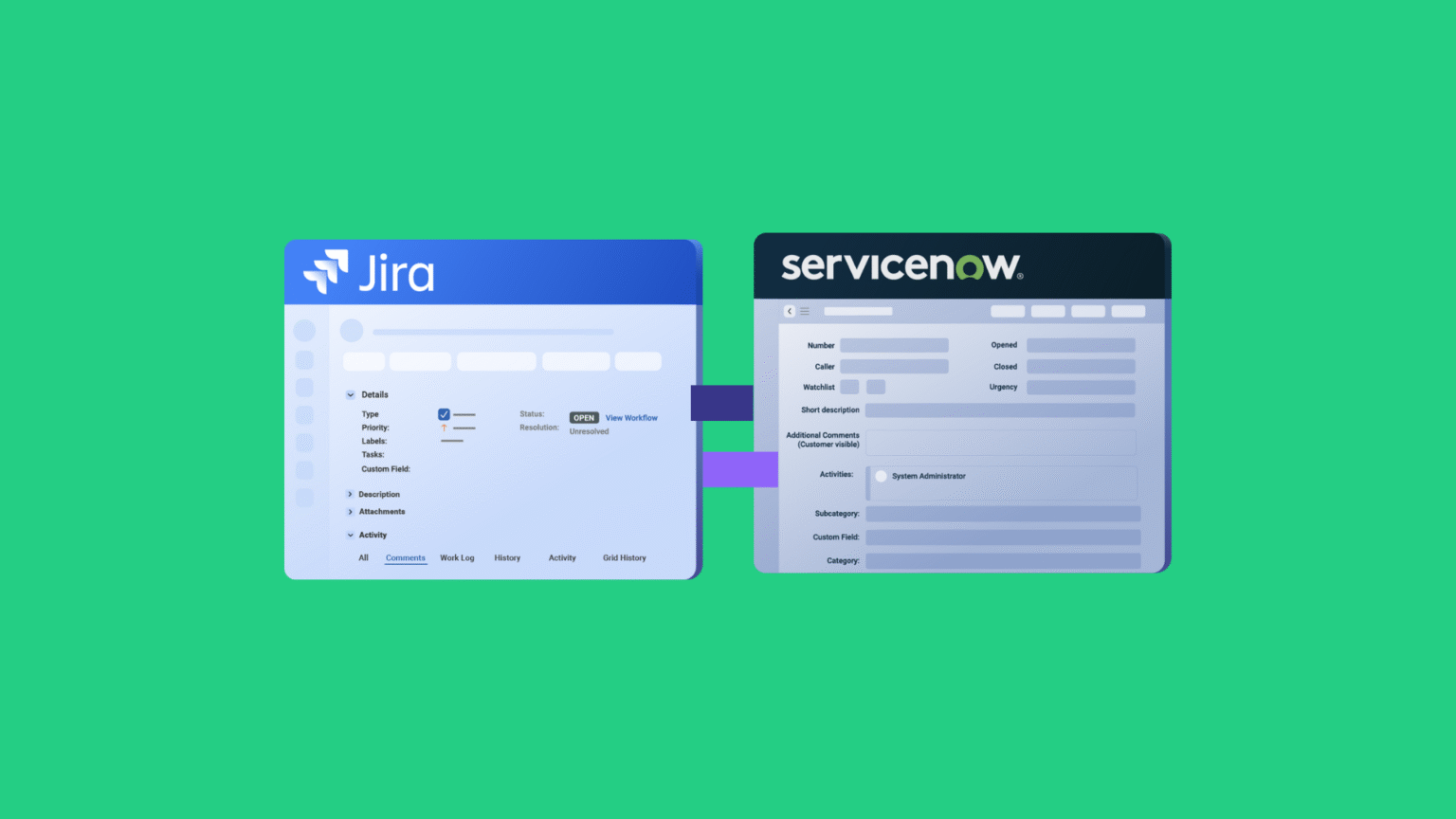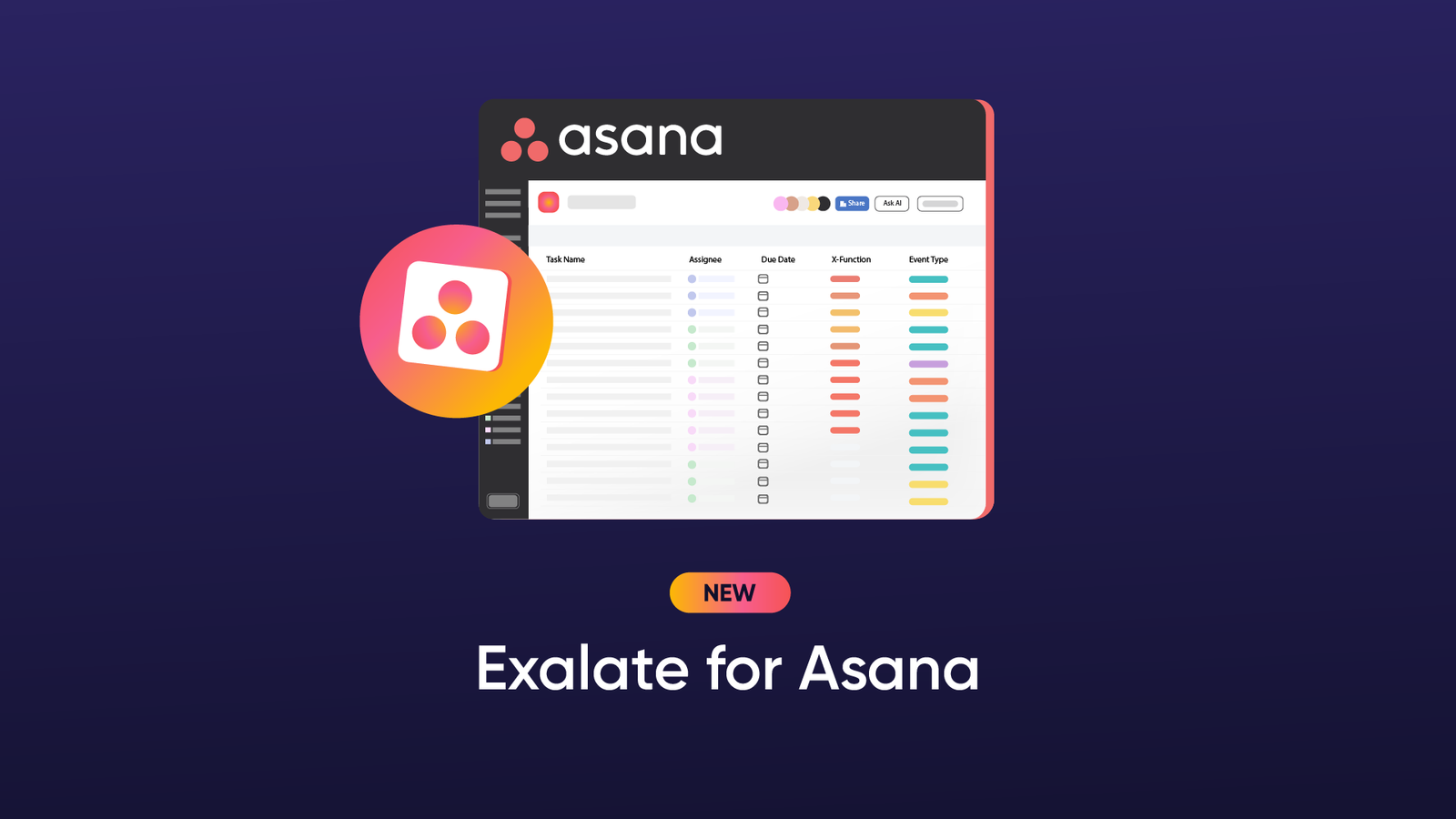After implementing countless integrations between Jira (and Jira Service Management) and ServiceNow, our head of support and services has learned that service management workflows rarely fit into neat boxes.
Recently, he walked me through some practical use cases he’s been handling with customers, and they highlight just how diverse these integration needs really are.
What stands out is that both JSM and ServiceNow excel at service delivery, but they serve different purposes. Jira works well for internal teams and agile service operations, while ServiceNow dominates enterprise-wide ITSM with complex workflows and governance.
Without proper integration, teams end up duplicating work, losing communication context, and dealing with delayed incident response.
Here are the real scenarios we’ve gathered based on conversations with service providers, multi-partner operations, and federated ITSM environments.
Key Takeaways
Jira-ServiceNow integration eliminates duplicate work, automates ticket syncing, and lets teams work in their preferred tools while maintaining real-time visibility.
Use Cases Covered
- Critical escalation,
- Change management,
- L1/L2 support separation,
- Problem management,
- Service catalog workflows,
- Incident-to-bug tracking,
- Agile-ITSM coordination,
- CMDB sync,
- Partner collaboration,
- Multi-instance operations.
Problems Solved: Manual ticket duplication, lost context during escalations, approval bottlenecks, disconnected workflows, and delayed incident response.
Use Case 1: Critical Issue Escalation for Contractual Compliance
Current Setup: Many support organizations use Jira for day-to-day work item tracking, but face contractual requirements to log critical issues in ServiceNow. Support agents (often 300+ users) track all work in Jira, but specific customers require incidents in ServiceNow for SLA tracking and compliance.

Problem: Manually creating ServiceNow incidents for flagged Jira work items creates significant overhead. Support agents need to duplicate information, switch systems, and manually keep both records in sync.
Solution: Implement trigger-based automation where Jira work items with specific labels (like “critical” or “customer-escalation”) automatically create corresponding ServiceNow incidents. Status updates, comments, and resolutions sync bidirectionally so agents can work primarily in Jira while maintaining ServiceNow records for compliance.
Use Case 2: Change and Release Coordination
Current Setup: Development and operations teams track work in Jira Service Management (JSM). Enterprise Change Management processes run in ServiceNow for audit and compliance.

Problem: Every release or deployment requires manual Change Request creation in ServiceNow. This duplicates information and creates approval bottlenecks.
Solution: JSM changes or releases automatically generate ServiceNow Change Requests with relevant technical details. Approval workflows in ServiceNow reference JSM status. Once approved, changes sync back to JSM for implementation tracking.
Use Case 3: Two-Tier Support Structure with System Separation
Current Setup: Organizations implementing first-line (L1) and second-line (L2) support often want different teams working in their preferred tools. L1 support receives and triages tickets in ServiceNow, while L2 technical teams and developers work exclusively in Jira.

Problem: Without integration, L1 agents must manually create Jira work items for escalations, then constantly check back to update ServiceNow tickets. Information gets lost, status updates lag, and both teams waste time coordinating.
Solution: When L1 support escalates a ServiceNow incident or request to L2, it automatically creates a linked Jira work item in the appropriate project. All comments, attachments, and status changes sync bidirectionally. L1 agents stay in ServiceNow, developers stay in Jira, but everyone sees real-time updates.

JSM and ServiceNow are both solid platforms, but getting them to play nice together has been a massive headache for my team. We finally figured it out with Exalate, so things work way smoother at the moment.
— HEAD OF IT
Use Case 4: Problem and Catalog Task Management
Current Setup: ServiceNow tracks various record types, such as Incidents, Changes, Problems, and Catalog Tasks. JSM handles technical investigation and resolution.

Problem: Not all ServiceNow record types need the same treatment. Problems need root cause analysis in JSM, catalog tasks need development work, and simple incidents might stay in ServiceNow.
Solution: Configure selective sync based on ServiceNow record type and criteria. Problems automatically create JSM investigation tasks. Catalog tasks become JSM stories for development. Status categories in ServiceNow determine when JSM involvement triggers.
Use Case 5: Change Management Workflow Integration
Current Setup: Development teams tracking releases and deployments in Jira need those changes reflected in ServiceNow’s Change Management process for approval and governance.
Problem: Creating Change Requests manually in ServiceNow for every Jira release or deployment creates bottlenecks. Teams need to duplicate release information, track approvals separately, and manually update both systems throughout the change lifecycle.
Solution: When a Jira version/release is created or reaches a specific status, it automatically generates a ServiceNow Change Request with relevant details. The Change Request approval process in ServiceNow can leverage Jira status information. Once approved in ServiceNow, the change status syncs back to Jira so development teams can proceed.
Use Case 6: Service Catalog (or RITM) to Development Task Flow
Current Setup: Business users submit requests through ServiceNow Service Catalog. IT evaluates these RITMs (Requested Items) and determines which ones need development work.

Problem: Manually converting approved catalog requests into Jira stories loses context. Development teams don’t have visibility into the original business request, and business stakeholders can’t track development progress without switching to Jira.
Solution: When a ServiceNow RITM, Service Task, or Catalog Task meets specific criteria (approval status or category), it automatically creates a Jira story in the appropriate project. Requirements, attachments, status updates, comments, and business context sync back to ServiceNow so requestors stay informed.
Use Case 7: Incident-to-Bug and Problem Management
Current Setup: ServiceNow handles incident management and problem identification, while development teams use Jira for bug tracking and code changes.

Problem: When incidents reveal underlying bugs or problems that require development fixes, manually creating Jira bugs loses incident context and history. Teams can’t easily trace from incident through root cause analysis to code fix.
Solution: ServiceNow incidents or problems automatically create linked Jira bugs when they meet specific criteria (category, severity, assignment group). The bug inherits relevant incident details. When developers resolve the bug in Jira, the ServiceNow problem automatically updates, maintaining end-to-end traceability.

I’ve seen what happens when service teams try to maintain tickets in both Jira and ServiceNow manually. It’s a mess—lost context, delayed responses, frustrated agents. Since we integrated our sites, we’ve seen huge gains in workflow efficiency and incident resolution.
— PROJECT MANAGER
Use Case 8: Agile Development with ITSM Oversight
Current Setup: Smaller agile development teams use Jira Software for backlog management, sprint planning, and task tracking. The broader organization uses ServiceNow for all IT service tracking, including requests and enhancements.
Problem: Business stakeholders and service managers can’t see development progress without Jira access. Development teams don’t want to leave Jira but need to update ServiceNow for organizational visibility.
Solution: ServiceNow tracks all incoming requests and enhancement ideas. When items are approved for development, they sync to Jira as backlog items. Development teams work entirely in Jira with complete agile workflows.
Use Case 9: CMDB and Business Application Sync
Current Setup: ServiceNow CMDB contains authoritative records for business applications, services, and infrastructure, which developers need access to from their Jira.

Problem: CMDB data changes frequently. Manually updating Jira with application information leads to stale data and disconnected planning.
Solution: Push business application records from ServiceNow CMDB to Jira as configuration items or custom objects. Updates to CMDB records automatically sync to keep Jira current. Development teams can link work items to specific applications, services, or infrastructure components.
Use Case 10: External Partner and Vendor Collaboration
Current Setup: One organization uses ServiceNow while their partner or vendor uses Jira (or vice versa). Both need visibility into shared work.
Problem: Partners can’t access internal ServiceNow instances. At the same time, manual email updates or spreadsheet tracking create delays and errors.
Solution: Selective bidirectional sync between internal ServiceNow and partner Jira instances. Only relevant work items sync based on project, customer, or category. Both organizations work in their preferred tool while maintaining shared visibility.
Use Case 11: Security Operations and Client-Facing Incident Management
Current Setup: A cybersecurity company uses JSM to receive, analyze, and remediate security alerts and incidents for multiple clients. One client manages their security posture through ServiceNow.
Problem: The client wants real-time visibility into security incidents without accessing the provider’s JSM instance. Manual updates create delays in critical security situations where response time matters.
Solution: Implement bidirectional sync between the provider’s JSM instance and the client’s ServiceNow. When a security alert is created in JSM, a corresponding incident appears in the client’s ServiceNow instance with comments and optional SLA sync.
Use Case 12: Multi-Instance ITSM Operations
Current Setup: Large enterprises sometimes run multiple ServiceNow instances (by region, business unit, or acquisition) alongside JSM for specific teams or functions.

Problem: Incidents, changes, or problems need visibility across instances. Teams waste time tracking down information or manually copying tickets between systems.
Solution: Connect multiple JSM projects to different ServiceNow instances or one JSM instance to multiple ServiceNow instances based on organizational structure. Route tickets automatically based on content, category, or affected service.
If you want to learn more about implementing ServiceNow-Jira integration for your specific use case, get in touch with our team to discuss your requirements.
Reading Recommendations:
- How to Sync Change Requests Between Jira and ServiceNow
- How AI-Powered Jira ServiceNow Integration Can Transform Your Workflow
- Practical Jira ServiceNow Integration Use Cases
- Jira ServiceNow Integration: Connect Jira & ServiceNow
- How to Sync SLA Records and Maintain State Updates From ServiceNow Incident to Jira Issue



